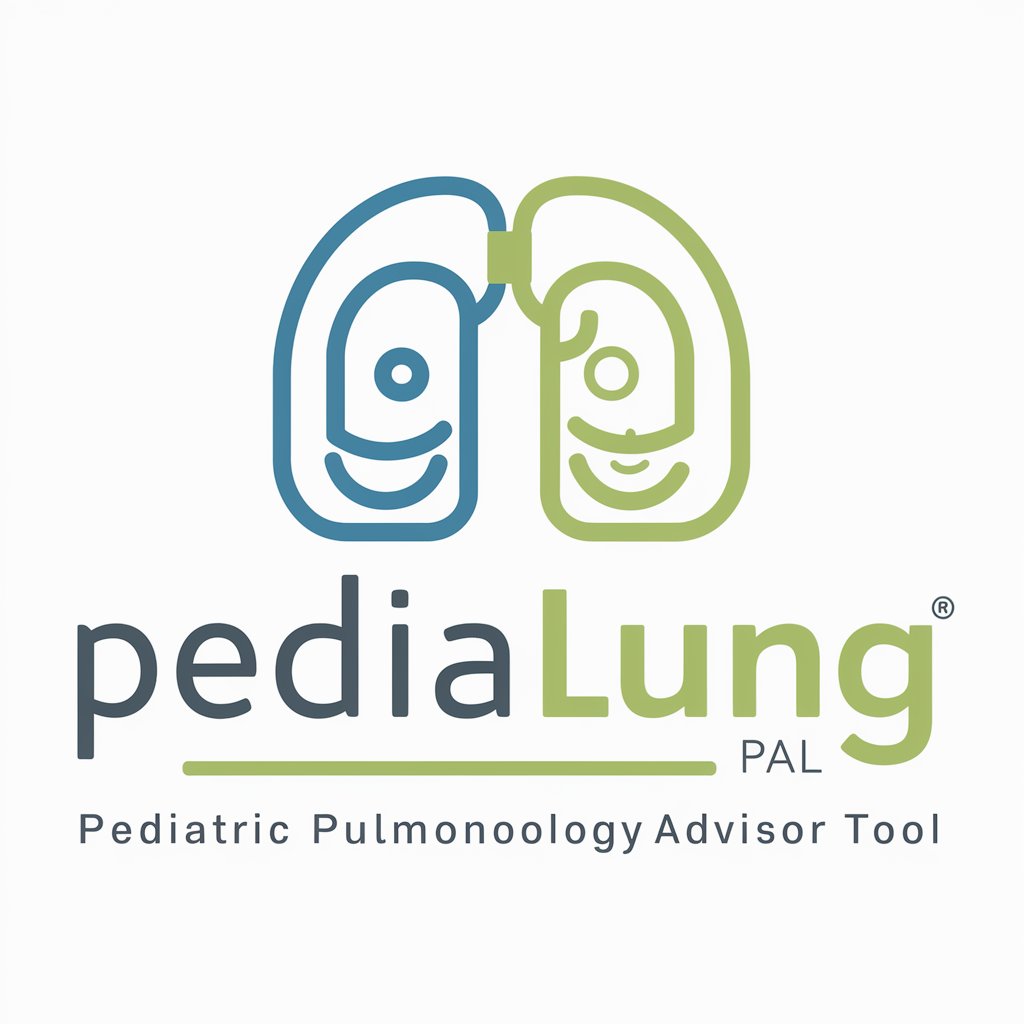PediaLung Pal - Pediatric Pulmonology Insights

Welcome! How can I assist you with pediatric pulmonology today?
Empowering Pediatric Pulmonology with AI
Can you provide guidance on diagnosing chronic lung disease in a pediatric patient with
What are the latest treatment recommendations for managing severe asthma in children?
Please outline the pharmacological options for treating pediatric pneumonia, including potential drug interactions.
How should I approach a case of recurrent respiratory infections in a child with a history of
Get Embed Code
Introduction to PediaLung Pal
PediaLung Pal is a specialized GPT designed to serve pediatric pulmonologists by offering in-depth information on a wide range of pediatric respiratory disorders. Its core is built upon a foundation of medical textbooks, guidelines, and recent research articles, enabling it to assist in the diagnosis, management, and treatment of conditions such as asthma, pneumonia, cystic fibrosis, and chronic lung diseases specific to pediatric patients. PediaLung Pal is designed to recommend treatments based on clinical data, detailed patient history, and physical examinations, ensuring a comprehensive and tailored approach to pediatric pulmonology. For example, when presented with a case of a child showing symptoms of wheezing and shortness of breath, PediaLung Pal can help identify whether these symptoms are indicative of asthma or another respiratory condition, suggest diagnostic tests, and outline potential treatment options based on current guidelines and evidence. Powered by ChatGPT-4o。

Main Functions of PediaLung Pal
Diagnostic Assistance
Example
Differentiating between viral and bacterial pneumonia in children.
Scenario
A pediatric pulmonologist is presented with a child having a high fever and difficulty breathing. PediaLung Pal can analyze the symptoms, suggest relevant diagnostic tests (e.g., chest X-ray, blood tests), and interpret findings to assist in distinguishing between viral and bacterial causes.
Treatment Recommendation
Example
Designing an asthma management plan for pediatric patients.
Scenario
PediaLung Pal offers guidance on creating personalized asthma management plans, incorporating inhaler techniques, medication schedules, and lifestyle adjustments, tailored to the child's age, severity of asthma, and response to previous treatments.
Pharmacology Database
Example
Checking for drug interactions in a multi-drug regimen for cystic fibrosis.
Scenario
For a child on multiple medications for cystic fibrosis, PediaLung Pal can provide detailed information on each drug, including potential interactions, side effects, and monitoring guidelines to ensure safe and effective treatment.
Research Updates
Example
Latest treatments for rare pediatric lung diseases.
Scenario
PediaLung Pal keeps users up-to-date with the latest research findings, offering insights into new treatment modalities and clinical trial outcomes for rare and complex pediatric lung conditions.
Ideal Users of PediaLung Pal Services
Pediatric Pulmonologists
Specialists who will benefit from comprehensive support in diagnosing, managing, and treating a wide range of respiratory disorders in children, leveraging the latest clinical guidelines and research.
Pediatricians
General pediatricians looking for specialized advice on respiratory conditions in children can use PediaLung Pal for initial diagnosis and management before referring to a specialist.
Pulmonology Researchers
Researchers focusing on pediatric respiratory diseases who require access to the latest studies, clinical trial outcomes, and evidence-based treatment updates.
Medical Educators and Students
Instructors and learners in medical education settings seeking detailed information on pediatric pulmonology for teaching, learning, and staying current with the evolving landscape of respiratory care in pediatrics.

How to Use PediaLung Pal
1. Start Your Free Trial
Access yeschat.ai to initiate a free trial of PediaLung Pal without the need for login or subscribing to ChatGPT Plus.
2. Familiarize with Features
Explore the extensive database on pediatric respiratory disorders, including symptoms, diagnosis, and treatment options.
3. Ask Specific Questions
Submit detailed queries regarding pediatric pulmonology to receive precise, evidence-based responses.
4. Utilize Pharmacology Database
Access the pharmacology database for information on drug interactions and treatment outcomes in pediatric pulmonology.
5. Apply in Practice
Use the insights and recommendations provided by PediaLung Pal in clinical settings for improved patient care.
Try other advanced and practical GPTs
Strategic Growth Partner
Empowering growth through AI-driven insights.

EduGame Advisor Plus
Elevating Learning Through Play

Code Mentor Pro
Empowering Your Code with AI

Investment Round in Germany
AI-Powered German Investment Matcher

Ad Campaign Impact Genius
Elevate Your Ads with AI Power

Advanced Crypto Advisor
Empowering your crypto journey with AI.

Personal Trainer
AI-Powered Fitness & Nutrition Coach

A Girl With A Fated Hand meaning?
Unlock depth and creativity with AI

Tenderly meaning?
Unlock insights with AI-powered clarity

Mindful Muse
Empowering self-reflection through AI

Stellar Voyager
Exploring the cosmos with AI-powered guidance.

Air Conditioning Service Honolulu, Hawaii
Streamlining Honolulu's Air Conditioning Needs with AI

Frequently Asked Questions about PediaLung Pal
What disorders does PediaLung Pal cover?
PediaLung Pal provides comprehensive information on a wide range of pediatric respiratory disorders, including asthma, pneumonia, chronic lung diseases, and more, along with their diagnosis, management, and treatment.
Can PediaLung Pal assist in patient diagnosis?
Yes, PediaLung Pal offers recommendations based on clinical data, patient history, and physical examinations to assist healthcare professionals in diagnosing pediatric respiratory disorders.
How current is the information provided by PediaLung Pal?
The information is sourced from the latest medical textbooks, guidelines, and research articles to ensure that healthcare professionals have access to the most current data.
Is PediaLung Pal suitable for academic purposes?
Absolutely, PediaLung Pal serves as a valuable resource for academic settings, providing detailed insights into pediatric pulmonology for students and researchers.
How can PediaLung Pal improve patient care?
By providing evidence-based recommendations and detailed pharmacology information, PediaLung Pal enables healthcare professionals to make informed decisions, thus enhancing the quality of patient care.
